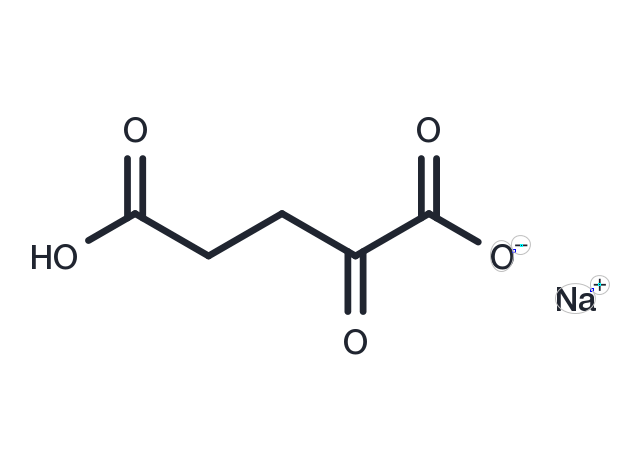Powder: -20°C for 3 years | In solvent: -80°C for 1 year


2-Ketoglutaric acid Sodium (AKG) is a key molecule in the TCA cycle. It can be produced from glutamate by oxidative deamination via glutamate dehydrogenase and as a product of pyridoxal phosphate-dependent transamination reactions (mediated by branched-chain amino acid transaminases) in which glutamate is a common amino donor.

| Pack Size | Availability | Price/USD | Quantity |
|---|---|---|---|
| 250 mg | In stock | $ 33.00 | |
| 1 mL * 10 mM (in DMSO) | In stock | $ 45.00 |


| Description | 2-Ketoglutaric acid Sodium (AKG) is a key molecule in the TCA cycle. It can be produced from glutamate by oxidative deamination via glutamate dehydrogenase and as a product of pyridoxal phosphate-dependent transamination reactions (mediated by branched-chain amino acid transaminases) in which glutamate is a common amino donor. |
| Targets&IC50 | Tyrosinase:15 mM (IC50) |
| In vitro | AKG is a nitrogen scavenger and a source of glutamate and glutamine that stimulates protein synthesis and inhibits protein degradation in muscles. In particular, AKG can decrease protein catabolism and increase protein synthesis to enhance bone tissue formation in skeletal muscles. It has recently been shown that AKG can extend the lifespan of adult C. elegans by inhibiting ATP synthase and TOR. In combination with molecular oxygen, alpha-ketoglutarate is required for the hydroxylation of proline to hydroxyproline in the production of type I collagen. A recent study has shown that alpha-ketoglutarate promotes TH1 differentiation along with the depletion of glutamine thereby favouring Treg (regulatory T-cell) differentiation. |
| Synonyms | Oxoglutaric acid, AKG, 2-oxoglutarate monobasic, α-Ketoglutaric acid sodium salt |
| Molecular Weight | 168.08 |
| Formula | C5H5NaO5 |
| CAS No. | 22202-68-2 |
Powder: -20°C for 3 years | In solvent: -80°C for 1 year
DMSO: 50 mg/mL (297.48 mM)
You can also refer to dose conversion for different animals. More
bottom
Please see Inhibitor Handling Instructions for more frequently ask questions. Topics include: how to prepare stock solutions, how to store products, and cautions on cell-based assays & animal experiments, etc.
2-Ketoglutaric acid Sodium 22202-68-2 Metabolism Proteases/Proteasome Tyrosinase Endogenous Metabolite alpha-Ketoglutaric acid sodium α-Ketoglutaric acid sodium Oxoglutaric acid AKG intermediate 2-oxoglutarate monobasic inhibit TCA precursor carbon skeleton Alpha-Ketoglutaric acid 2 Ketoglutaric acid Sodium 2-Ketoglutaric acid α-Ketoglutaric acid sodium salt 2Ketoglutaric acid Sodium Inhibitor a-Ketoglutaric acid sodium inhibitor
